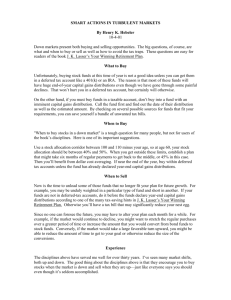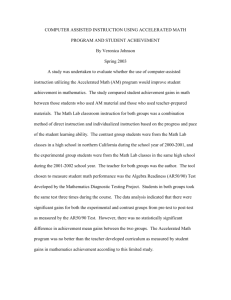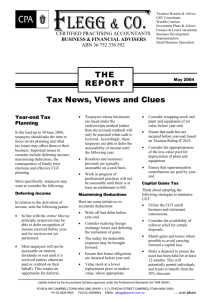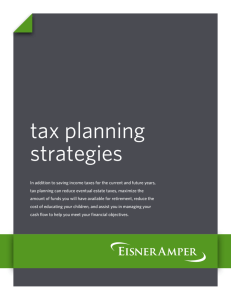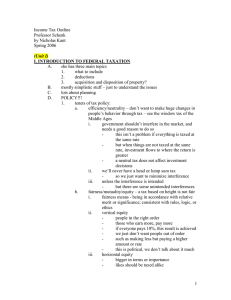Year-End Tax Planning: 2005 Strategies for Individuals & Businesses
advertisement
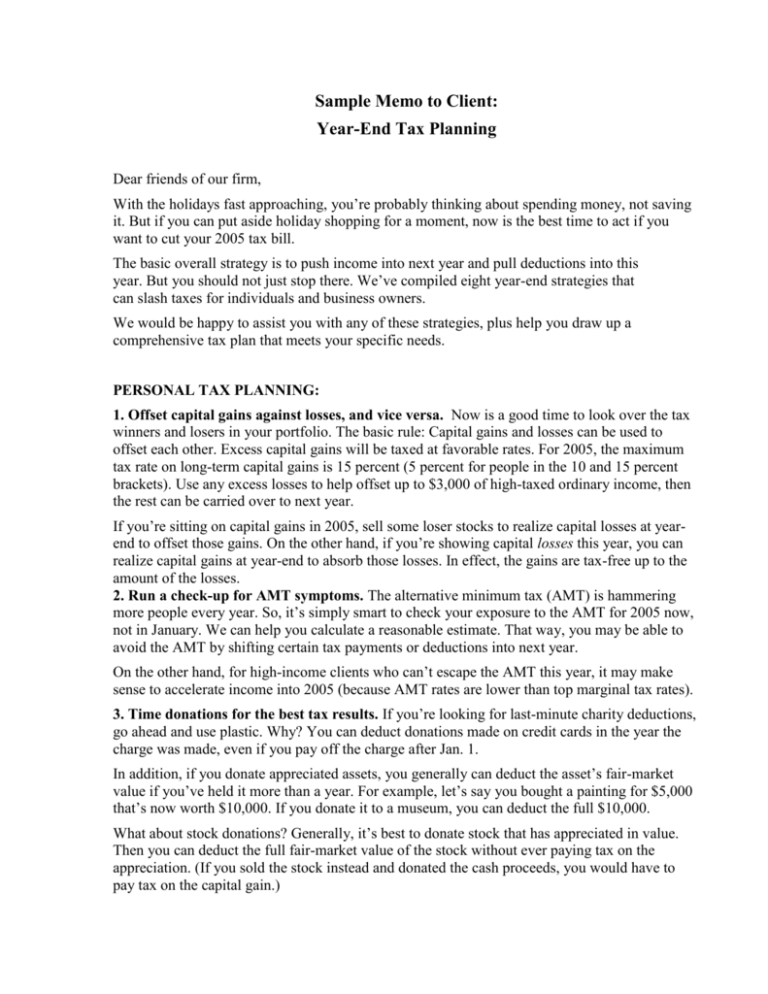
Sample Memo to Client: Year-End Tax Planning Dear friends of our firm, With the holidays fast approaching, you’re probably thinking about spending money, not saving it. But if you can put aside holiday shopping for a moment, now is the best time to act if you want to cut your 2005 tax bill. The basic overall strategy is to push income into next year and pull deductions into this year. But you should not just stop there. We’ve compiled eight year-end strategies that can slash taxes for individuals and business owners. We would be happy to assist you with any of these strategies, plus help you draw up a comprehensive tax plan that meets your specific needs. PERSONAL TAX PLANNING: 1. Offset capital gains against losses, and vice versa. Now is a good time to look over the tax winners and losers in your portfolio. The basic rule: Capital gains and losses can be used to offset each other. Excess capital gains will be taxed at favorable rates. For 2005, the maximum tax rate on long-term capital gains is 15 percent (5 percent for people in the 10 and 15 percent brackets). Use any excess losses to help offset up to $3,000 of high-taxed ordinary income, then the rest can be carried over to next year. If you’re sitting on capital gains in 2005, sell some loser stocks to realize capital losses at yearend to offset those gains. On the other hand, if you’re showing capital losses this year, you can realize capital gains at year-end to absorb those losses. In effect, the gains are tax-free up to the amount of the losses. 2. Run a check-up for AMT symptoms. The alternative minimum tax (AMT) is hammering more people every year. So, it’s simply smart to check your exposure to the AMT for 2005 now, not in January. We can help you calculate a reasonable estimate. That way, you may be able to avoid the AMT by shifting certain tax payments or deductions into next year. On the other hand, for high-income clients who can’t escape the AMT this year, it may make sense to accelerate income into 2005 (because AMT rates are lower than top marginal tax rates). 3. Time donations for the best tax results. If you’re looking for last-minute charity deductions, go ahead and use plastic. Why? You can deduct donations made on credit cards in the year the charge was made, even if you pay off the charge after Jan. 1. In addition, if you donate appreciated assets, you generally can deduct the asset’s fair-market value if you’ve held it more than a year. For example, let’s say you bought a painting for $5,000 that’s now worth $10,000. If you donate it to a museum, you can deduct the full $10,000. What about stock donations? Generally, it’s best to donate stock that has appreciated in value. Then you can deduct the full fair-market value of the stock without ever paying tax on the appreciation. (If you sold the stock instead and donated the cash proceeds, you would have to pay tax on the capital gain.) Conversely, you should hold onto stock that’s declined in value, or sell it at a loss. If the sales proceeds are donated, you can use the tax loss to offset other capital gains. Of course, you should take factors other than taxes into the equation. 4. Reduce tax on real estate through installment sales. Income received from real estate sales is usually taxable in the year it’s received. But you can spread out the tax bite by selling property on the installment basis. For example, if you sell real estate and receive one payment in December and another sometime next year, the profit will be taxed over two years instead of one. (Not only do installment sales help defer taxes, they can reduce the overall tax bill if you’re in a lower tax bracket in those future years when you receive the payments.) BUSINESS TAX PLANNING 5. Max out on the Section 179 deduction. The Section 179 deduction allows business owners to write off up to $105,000 of the cost of qualifying depreciable business assets. To take full advantage of the tax break, you should acquire and place assets in service by year-end. Note: The amount expensed can’t exceed your company’s taxable income for the year. Plus, the allowance is reduced on a dollar-for-dollar basis for large purchases exceeding an annual threshold ($420,000 for 2005). 6. Go back and forth with NOLs. If a company incurs a net operating loss (NOL), it can carry back the loss for two years and then forward for up to 20 years. So, your company generally can use a NOL from this year to offset highly taxed income from the past two years. Typically, business owners will postpone taxable income to next year to secure a NOL for this year. For instance, you may delay billing on jobs to delay receiving the income until 2006. Similarly, you might accelerate the purchase of routine deductible items from next year into this year to offset current income. 7. Give business gifts to companies, not people. Business-gift deductions are limited to $25 per recipient. But that restriction applies to gifts for individuals, not companies. So you should direct holiday gifts to your customers’ companies in general, not to individuals in those companies. That way, you can deduct the entire cost of any size gift. On a related note, there’s a way to write off the full cost of a holiday party. Normally, deductions for business entertainment are limited to 50 percent of the cost. But you can deduct 100 percent of the cost of employee parties if you invite all employees (not just the top brass). Also, you can snare a 50 percent write-off for hosting a holiday party at home for friends and business associates, as long as the party follows a “substantial business discussion.” 8. Travel on business in tax style. Business travelers can move up trips planned for January into December to write off the travel expenses in 2005 instead of waiting until 2006. Note that unreimbursed travel expenses must be deducted as miscellaneous expenses subject to the 2 percent-of-AGI limit. Very truly yours,
